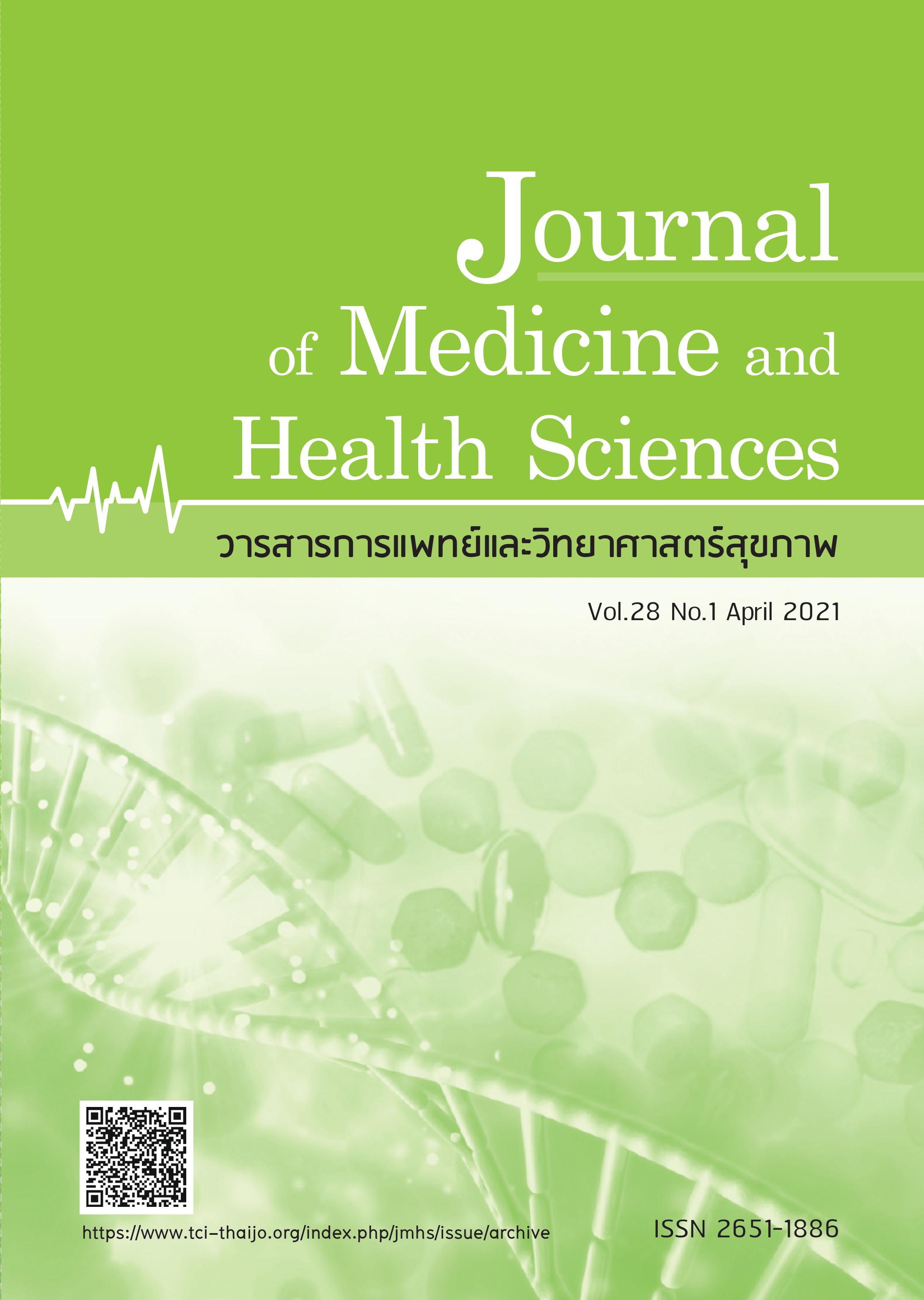The correlation between ultrasound results and operative findings in women undergoing repeat Cesarean sections
Keywords:
: intra-abdominal adhesion, repeated cesarean section, ultrasoundAbstract
Repeated cesarean delivery increases the risk of complications due to surgery potential causing intra‐abdominal adhesions. The study used an ultrasound (US) to predict adhesions for reducing complications were seen in a foreign country. This study has two objectives, as follows: (1) to assess the correlation of US finding and intra-abdominal adhesion by negative and positive sliding sign; and (2) to compare the accuracy of difference in locations of placing US probes to predict intra-abdominal adhesion. This was a prospective observational study of pregnant women with history of at least one Cesarean delivery. Patient histories were collected during antenatal care and performed a sliding sign test using US machine then classified patients into three groups (test positive, intermediate and negative). US probes were placed into two locations (halfway point between umbilicus and pubic symphysis = Probe 1, other suprapubic = Probe 2) to compare predictive accuracy. The patients collected data again after repeated cesarean deliveries. The results of the US test and intra-operative findings were compared again. The results were that 470 patients completed the study. The prediction of an intra-abdominal adhesion using US was compared in both locations of the placing probe. It was found that sensitivity was at 34.62% specificity at 99.32% in Probe 1, with a sensitivity of 50.00%, and a specificity of 98.65% in Probe 2. Severe adhesion was found in 75% and 68.4% of the sliding sign negative group in Probe 1 and Probe 2, respectively. The positive sliding sign found no intra-abdominal adhesion during repeated cesarean deliveries at 92.5% and 93.1% in in Probe 1 and Probe 2, respectively. The sliding sign test in the US findings predicted intra-abdominal adhesion due to the adhesion to the abdominal and uterine wall together and causing a sliding sign negative test. Probe 2 was more accurate than Probe 1 because adhesion usually occurred at the site of the surgery, so the probes nearer to that site were more accurate. This study found a correlation between the trans-abdominal ultrasound and operative findings. Probe 1 predicted severe intra-abdominal adhesion with sensitivity 50.00% and specificity 98.65%, which was placed in the suprapubic area and had greater accuracy than the probe used at the halfway point between the umbilicus and the pubic symphysis.
References
2. Molina G, Weiser TG, Lipsitz SR, et al. Relationship between cesarean delivery rate and maternal and neonatal mortality. JAMA 2015;314:2263-70.
3. He Z, Cheng Z, Wu T, et al. The Costs and Their Determinant of Cesarean Section and Vaginal Delivery: An Exploratory Study in Chongqing Municipality, China. Biomed
Res Int 2016;2016:5685261.
4. Tulandi T, Agdi M, Zarei A, et al. Adhesion Development and Morbidity After Repeat Cesarean Delivery. Am J Obstet Gynecol 2009;201:56.e1-e6.
5. Makoha FW, Felimban HM, Fathuddien MA, et al. Multiple cesarean section morbidity. Int J Gynaecol Obstet 2004;87:227-32.
6. Morales KJ, Gordon MC, Bates GW Jr. Postcesarean delivery adhesions associated with delayed delivery of infant. Am J Obstet Gynecol 2007;196:461.e1.
7. Uygur D, Gun O, Kelekci S, et al. Multiple repeat caesarean section: Is it safe?. Eur J Obstet Gynecol Reprod Biol 2005;119:71.
8. Hesselman S, Högberg U, Råssjö EB, et al. Abdominal adhesions in gynaecologic surgery after caesarean section: a longitudinal population-based register study. BJOG 2018;125:597.
9. Marshall NE, Fu R, Guise JM. Impact of multiple cesarean deliveries on maternal morbidity: A systematic review. Am J Obstet Gynecol 2011;205:262.e1-e8.
10. Cook JR, Jarvis S, Knight M, et al. Multiple repeat caesarean section in the UK: incidence and consequences to mother and child. A national, prospective, cohort study. BJOG 2013;120:85.
11. Silver RM, Landon MB, Rouse DJ, et al, Thom EA, et al. Maternal morbidity associated with multiple repeat cesarean deliveries. Obstet Gynecol 2006;107:1226.
12. Drukker L, Sela HY, Reichman O, et al. Sliding Sign for Intra-abdominal Adhesion Prediction before Repeat Cesarean Delivery. Obstet Gynecol 2018;52:662-5.
13. Baron J, Tirosh D, Mastrolia SA, et al. Sliding sign in third-trimester sonographic evaluation of intra-abdominal adhesions in women undergoing repeat Cesarean section: a novel technique. Ultrasound Obstet Gynecol 2018;52:662-5.



